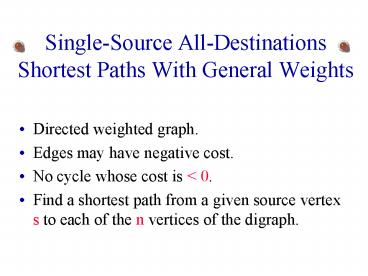Single-Source All-Destinations Shortest Paths With General Weights PowerPoint PPT Presentation
Title: Single-Source All-Destinations Shortest Paths With General Weights
1
Single-Source All-Destinations Shortest Paths
With General Weights
- Directed weighted graph.
- Edges may have negative cost.
- No cycle whose cost is lt 0.
- Find a shortest path from a given source vertex s
to each of the n vertices of the digraph.
2
Single-Source All-Destinations Shortest Paths
With General Weights
- Dijkstras O(n2) single-source greedy algorithm
doesnt work when there are negative-cost edges.
3
Bellman-Ford Algorithm
- Single-source all-destinations shortest paths in
digraphs with negative-cost edges. - Uses dynamic programming.
- Runs in O(n3) time when adjacency matrices are
used. - Runs in O(ne) time when adjacency lists are used.
4
Strategy
- To construct a shortest path from the source to
vertex v, decide on the max number of edges on
the path and on the vertex that comes just before
v.
- Since the digraph has no cycle whose length is lt
0, we may limit ourselves to the discovery of
cycle-free (acyclic) shortest paths. - A path that has no cycle has at most n-1 edges.
5
Cost Function d
s
w
v
- Let d(v,k) (distkv) be the length of a shortest
path from the source vertex to vertex v under the
constraint that the path has at most k edges. - d(v,n-1) is the length of a shortest
unconstrained path from the source vertex to
vertex v. - We want to determine d(v,n-1) for every vertex v.
6
Value Of d(,0)
- d(v,0) is the length of a shortest path from the
source vertex to vertex v under the constraint
that the path has at most 0 edges.
- d(s,0) 0.
- d(v,0) infinity for v ! s.
7
Recurrence For d(,k), k gt 0
- d(v,k) is the length of a shortest path from the
source vertex to vertex v under the constraint
that the path has at most k edges. - If this constrained shortest path goes through no
more than k-1 edges, then d(v,k) d(v,k-1).
8
Recurrence For d(,k), k gt 0
- If this constrained shortest path goes through k
edges, then let w be the vertex just before v on
this shortest path (note that w may be s).
- We see that the path from the source to w must be
a shortest path from the source vertex to vertex
w under the constraint that this path has at most
k-1 edges. - d(v,k) d(w,k-1) length of edge (w,v).
9
Recurrence For d(,k), k gt 0
- d(v,k) d(w,k-1) length of edge (w,v).
s
w
v
- We do not know what w is.
- We can assert
- d(v,k) mind(w,k-1) length of edge (w,v),
where the min is taken over all w such that (w,v)
is an edge of the digraph. - Combining the two cases considered yields
- d(v,k) mind(v,k-1),
- mind(w,k-1) length
of edge (w,v)
10
Pseudocode To Compute d(,)
- // initialize d(,0)
- d(s,0) 0
- d(v,0) infinity, v ! s
- // compute d(,k), 0 lt k lt n
- for (int k 1 k lt n k)
- d(v,k) d(v,k-1), 1 lt v lt n
- for (each edge (u,v))
- d(v,k) mind(v,k), d(u,k-1)
cost(u,v)
11
Complexity
- Q(n) to initialize d(,0).
- Q(n2) to compute d(,k) for each k gt 0 when
adjacency matrix is used. - Q(e) to compute d(,k) for each k gt 0 when
adjacency lasts are used. - Overall time is Q(n3) when adjacency matrix is
used. - Overall time is Q(ne) when adjacency lists are
used. - Q(n2) space needed for d(,).
12
p(,)
- Let p(v,k) be the vertex just before vertex v on
the shortest path for d(v,k). - p(v,0) is undefined.
- Used to construct shortest paths.
13
Example
- Source vertex is 1.
14
Example
v
1
2
3
4
5
6
0
k
1
2
3
4
d(v,k)
p(v.k)
15
Example
v
1
2
3
4
5
6
4
k
10
5
d(v,k)
p(v.k)
16
Shortest Path From 1 To 5
1
-6
6
3
1
2
4
6
7
3
5
3
4
5
9
1
2
3
4
5
6
1
2
3
4
5
6
5
p(v,5)
d(v,5)
17
Observations
- d(v,k) mind(v,k-1),
- mind(w,k-1) length of edge
(w,v) - d(s,k) 0 for all k.
- If d(v,k) d(v,k-1) for all v, then d(v,j)
d(v,k-1), for all j gt k-1 and all v. - If we stop computing as soon as we have a d(,k)
that is identical to d(,k-1) the run time
becomes - O(n3) when adjacency matrix is used.
- O(ne) when adjacency lists are used.
18
Observations
- The computation may be done in-place.
- d(v) mind(v), mind(w) length of edge
(w,v) - instead of
- d(v,k) mind(v,k-1),
- mind(w,k-1) length of
edge (w,v) - Following iteration k, d(v,k1) lt d(v) lt d(v,k)
- On termination d(v) d(v,n-1).
- Space requirement becomes O(n) for d() and p().

